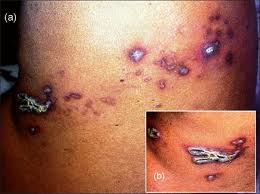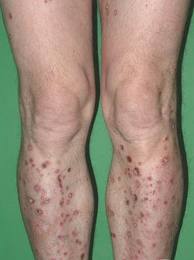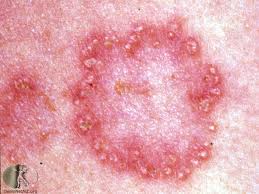It is a very rare skin disorder whereby there is an elimination of altered protein substance (called collagen) through the layer of skin (called epidermis). The two distinct forms are an inherited form that manifests in childhood and an acquired form that occurs in adulthood.

Only a few cases have been reported in the medical literature. At Life force, we have had a chance to record, treat and document such a case. (One case is not enough, though.)
It is also called the itching of renal failure, since it is very commonly seen in diabetic patients with renal failure on prolonged dialysis.
The major abnormality is focal damage to collagen followed by the elimination of the disrupted collagen through the epidermis.
Cold or superficial blunt trauma often precipitates the lesions, especially in the inherited form. The acquired form usually occurs in patients with diabetes or chronic renal failure, especially those receiving dialysis.
Acquired perforating collagenosis is more common, occurring in as many as 10% of patients receiving maintenance hemodialysis.
The lesions are intensely itchy, leaving some scarring after resolution.
The inherited form usually presents in infancy or early childhood. The acquired form occurs in adults.
Small, asymptomatic keratotic papules develop after minor trauma. The lesions start as pin-sized lesions, and they grow into larger papules over a few weeks. They heal with residual minor scarring.
Intense itching is a feature of acquired perforating collagenosis. In this condition, a history of diabetes or renal failure is often elicited.
Flesh-colored, dome-shaped papules as large as 10 mm in diameter are typical. They have a keratinous plug. Lesions may be in a linear pattern, exhibiting the Koebner phenomenon. Residual scarring may be seen from previously healed lesions. Lesions are most commonly found on the extensor surfaces of the limbs and the dorsa of the hands. Lesions may also occur on the trunk and the face.
Acquired perforating collagenosis can occur in other nephropathies without diabetes.
Acquired perforating collagenosis has been reported in association with hypothyroidism, hyperparathyroidism, liver dysfunction, lymphoma, and periampullary carcinoma.
Homeopathic treatment:
This is a rare disease and our experience is obviously limited to one case that we have treated at Life force, with good success. Looking at it being a form of collagen disease for which homeopathy has good treatment to offer, Reactive perforating collagenosis should find good control measure. Homeopathy is expected to relive the symptom, intense itching in particular and the skin lesions. Homeopathy is strongly suggested.





